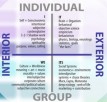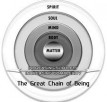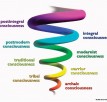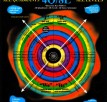
About Integral Theory
Integral Theory is a synthesizing philosophy and psychology brought to life by the world famous American philosopher and writer, Ken Wilber at the end of the 20th century. This exciting new theory that integrates body mind and spirit, in the territories of self, culture, and nature, gives us a professional synthesis of western psychology and the teachings of the great spiritual wisdom traditions.
Next »

An All-Inclusive Framework for the 21st Century
Sean Esbjörn-Hargens is associate professor and founding president of JFK University Integral Theory department and also the founding director of Integral Research Centre. He has been working in close cooperation with Ken Wilber for a decade in order to work out an integral model that is operable in many different contexts. Below you can read the article of Sean Esbjörn-Hargens about integral theory which he published at www.integrallife.com. Presently this is the main overviewing article on the international pages in this
theme.
Next »

All Quadrants: The Basic Dimension-Perspectives
According to integral theory, there are at least four irreducible perspectives (subjective, intersubjective, objective, and interobjective) that must be consulted when attempting to fully
understand any issue or aspect of reality.
Next »

All Levels: Depth and Complexity
Within each quadrant there are levels of development. Within the interior, Left-Hand quadrants there are levels of depth and within the exterior, Right-Hand quadrants there are levels of complexity. The levels within each quadrant are best understood as probability waves that represent the dynamic nature of reality and the ways different realities show up under certain conditions.
Next »

All Lines: Various Developmental Capacities
Lines of development are another way to describe the distinct capacities that develop through levels in each aspect of reality as represented by the quadrants. So if levels are contour-lines on a hiking map for reality, then lines of development represent the various trails you can take to transverse the vast wilderness of human potential.
Next »

All States: Temporary Expressions
In addition to levels and lines there are also various kinds of states associated with each quadrant. States are temporary occurrences of aspects of reality (lasting anywhere from a few seconds to days, and in some cases even months or years). They also tend to be incompatible with each other. For example, you cannot be drunk and sober at the same time, a town cannot experience a blizzard and a heat wave on the same day.
Next »

All Zones: Different Ways of Knowing
In addition to the five elements of integral theory, which comprise the basic foundation of the AQAL model, there is an another more advanced aspect that is important to mention. This
aspect is less of a new element and more of a complexification of the first one (the quadrants).
Next »

Integral Theory in Action
As you can see by now, an all-quadrants, all-levels, all-lines, all-states, all-types, and all-zones approach is pretty comprehensive. Of course, you do not have to use all of these distinctions all the time. In fact, even using two of these elements can make your approach to analysis or solution building more integral than many others.
Next »

Conclusion
The above examples are wonderfully far-ranging in their focus and scale. This variety of integral theory in action speaks directly to the flexibility and coherence of its theoretical
foundation: the AQAL model. By acknowledging the multifaceted nature of complex issues and problems, integral theory creates a space for multiple perspectives to contribute to the
discovery of viable solutions.
Next »
Notes
Next »
References
Next »



